A Report on the ERP and Supply Chain Management Failure at Nike Inc.
VerifiedAdded on 2019/10/18
|8
|1587
|100
Report
AI Summary
This report provides an in-depth analysis of the ERP and supply chain management implementation failure at Nike Inc. It begins with an introduction and company overview, highlighting Nike's business operations and financial performance. The analysis section delves into the specific challenges faced by Nike, including the unsuccessful implementation of the I2 software and its impact on demand forecasting and supply chain efficiency. The report identifies key issues such as inaccurate forecasting, the inability of the software to integrate with existing ERP systems, and the challenges of managing a complex supply chain. Prioritized issues are discussed, and recommendations are provided for improving IT system implementation, including the importance of effective strategies, stakeholder involvement, and project scope definition. The report concludes by emphasizing the need for a strategic approach to ERP implementation and the potential of solutions like SAP AFS. The provided references offer additional context and support for the analysis presented.
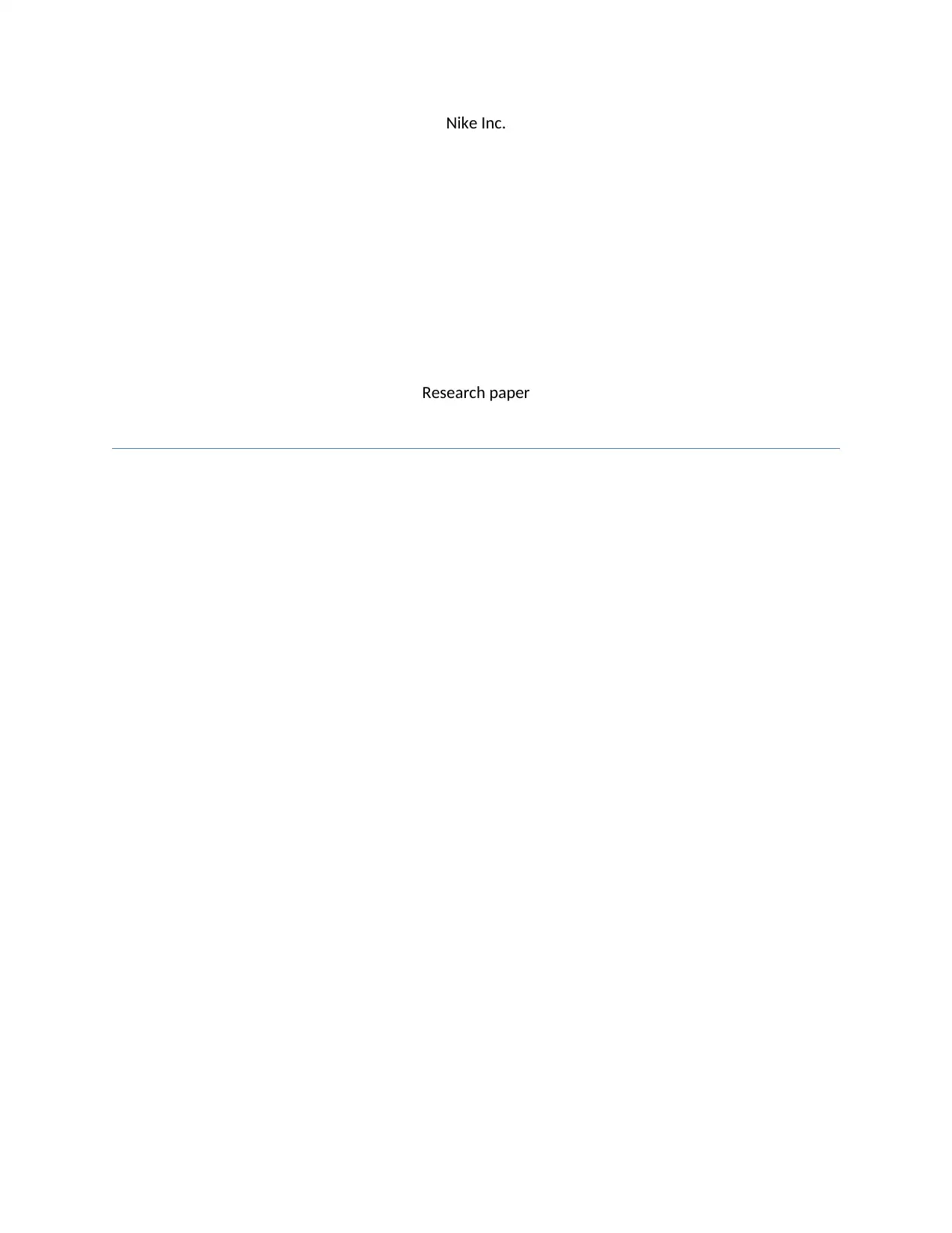
Nike Inc.
Research paper
Research paper
Paraphrase This Document
Need a fresh take? Get an instant paraphrase of this document with our AI Paraphraser
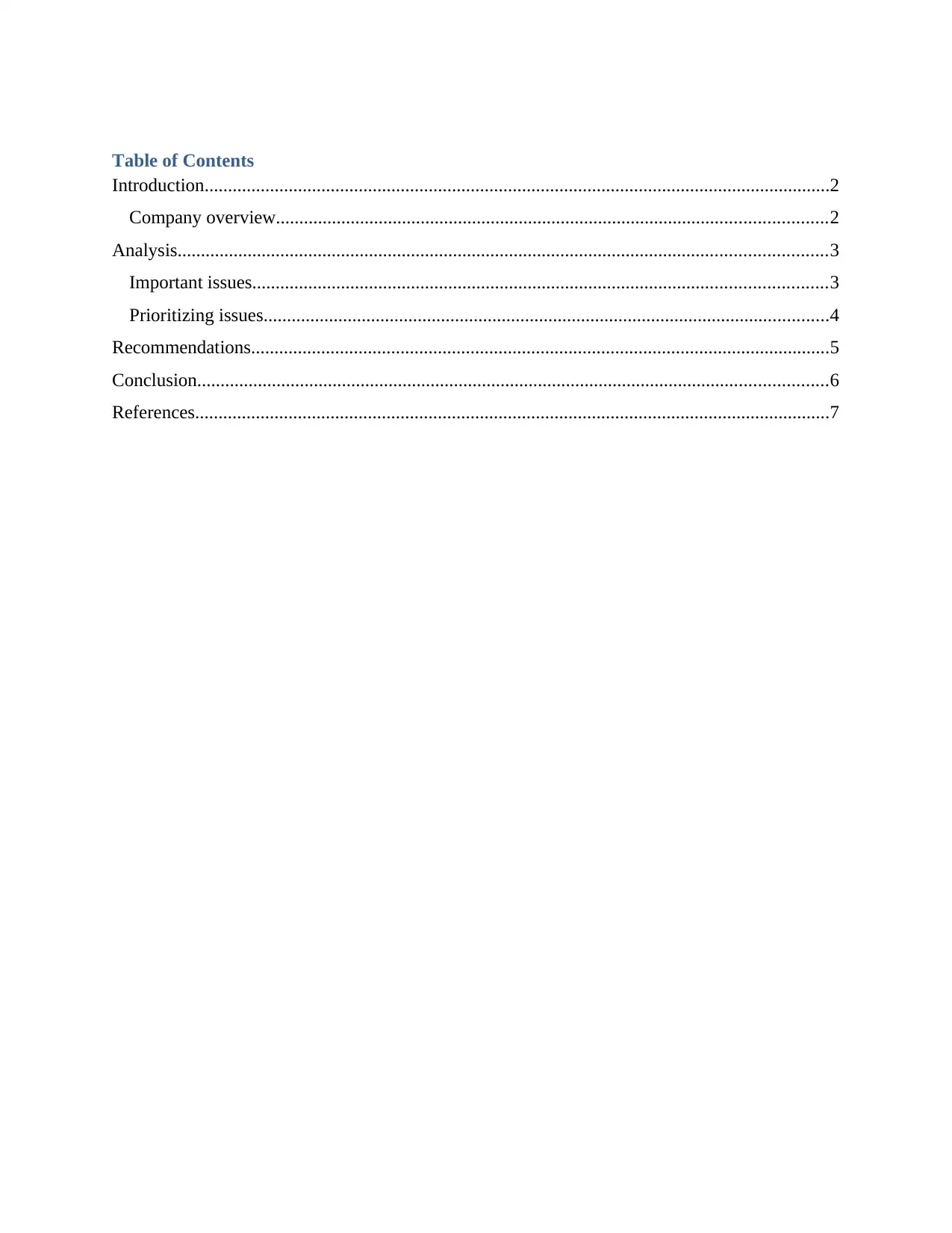
Table of Contents
Introduction......................................................................................................................................2
Company overview......................................................................................................................2
Analysis...........................................................................................................................................3
Important issues...........................................................................................................................3
Prioritizing issues.........................................................................................................................4
Recommendations............................................................................................................................5
Conclusion.......................................................................................................................................6
References........................................................................................................................................7
Introduction......................................................................................................................................2
Company overview......................................................................................................................2
Analysis...........................................................................................................................................3
Important issues...........................................................................................................................3
Prioritizing issues.........................................................................................................................4
Recommendations............................................................................................................................5
Conclusion.......................................................................................................................................6
References........................................................................................................................................7
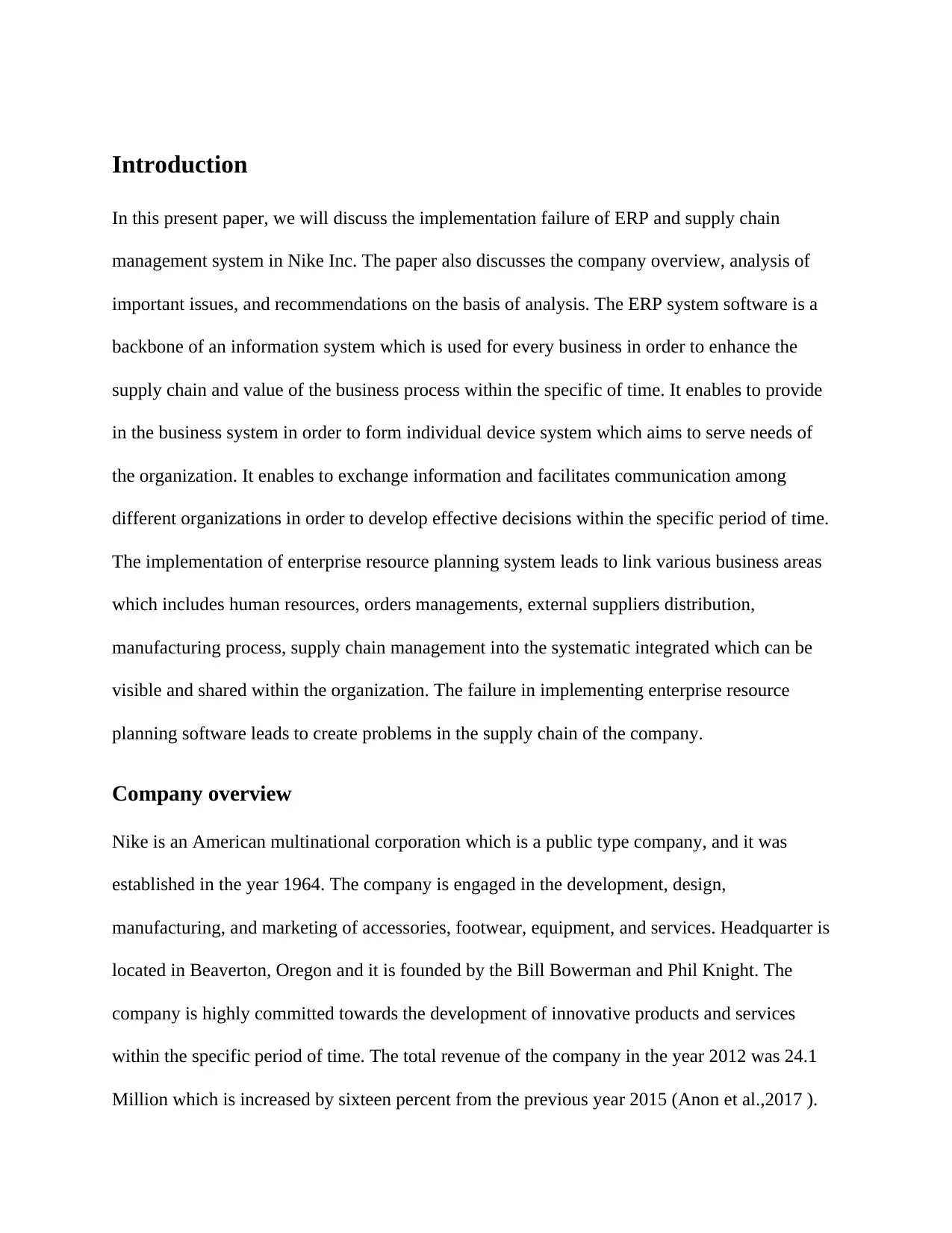
Introduction
In this present paper, we will discuss the implementation failure of ERP and supply chain
management system in Nike Inc. The paper also discusses the company overview, analysis of
important issues, and recommendations on the basis of analysis. The ERP system software is a
backbone of an information system which is used for every business in order to enhance the
supply chain and value of the business process within the specific of time. It enables to provide
in the business system in order to form individual device system which aims to serve needs of
the organization. It enables to exchange information and facilitates communication among
different organizations in order to develop effective decisions within the specific period of time.
The implementation of enterprise resource planning system leads to link various business areas
which includes human resources, orders managements, external suppliers distribution,
manufacturing process, supply chain management into the systematic integrated which can be
visible and shared within the organization. The failure in implementing enterprise resource
planning software leads to create problems in the supply chain of the company.
Company overview
Nike is an American multinational corporation which is a public type company, and it was
established in the year 1964. The company is engaged in the development, design,
manufacturing, and marketing of accessories, footwear, equipment, and services. Headquarter is
located in Beaverton, Oregon and it is founded by the Bill Bowerman and Phil Knight. The
company is highly committed towards the development of innovative products and services
within the specific period of time. The total revenue of the company in the year 2012 was 24.1
Million which is increased by sixteen percent from the previous year 2015 (Anon et al.,2017 ).
In this present paper, we will discuss the implementation failure of ERP and supply chain
management system in Nike Inc. The paper also discusses the company overview, analysis of
important issues, and recommendations on the basis of analysis. The ERP system software is a
backbone of an information system which is used for every business in order to enhance the
supply chain and value of the business process within the specific of time. It enables to provide
in the business system in order to form individual device system which aims to serve needs of
the organization. It enables to exchange information and facilitates communication among
different organizations in order to develop effective decisions within the specific period of time.
The implementation of enterprise resource planning system leads to link various business areas
which includes human resources, orders managements, external suppliers distribution,
manufacturing process, supply chain management into the systematic integrated which can be
visible and shared within the organization. The failure in implementing enterprise resource
planning software leads to create problems in the supply chain of the company.
Company overview
Nike is an American multinational corporation which is a public type company, and it was
established in the year 1964. The company is engaged in the development, design,
manufacturing, and marketing of accessories, footwear, equipment, and services. Headquarter is
located in Beaverton, Oregon and it is founded by the Bill Bowerman and Phil Knight. The
company is highly committed towards the development of innovative products and services
within the specific period of time. The total revenue of the company in the year 2012 was 24.1
Million which is increased by sixteen percent from the previous year 2015 (Anon et al.,2017 ).
⊘ This is a preview!⊘
Do you want full access?
Subscribe today to unlock all pages.

Trusted by 1+ million students worldwide
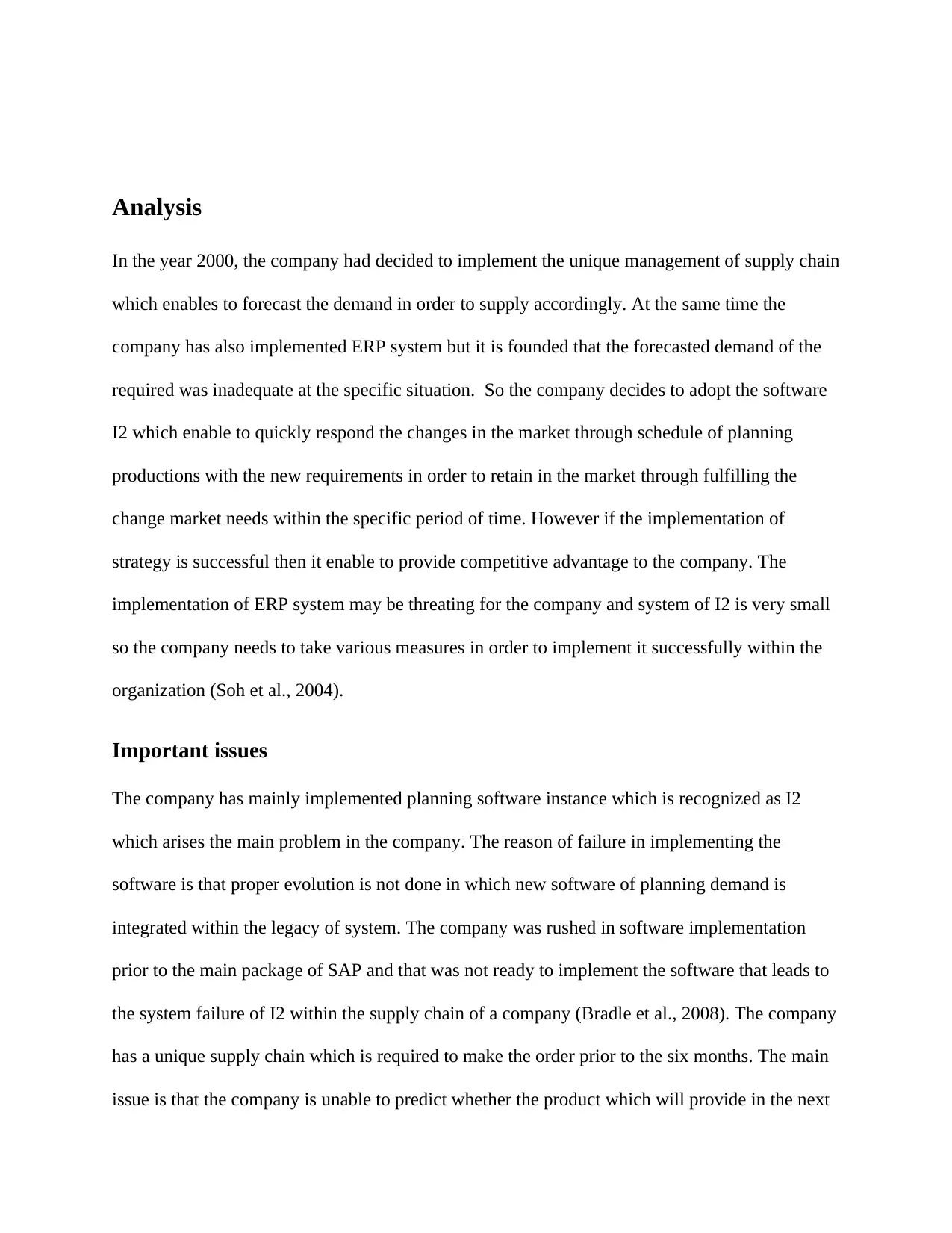
Analysis
In the year 2000, the company had decided to implement the unique management of supply chain
which enables to forecast the demand in order to supply accordingly. At the same time the
company has also implemented ERP system but it is founded that the forecasted demand of the
required was inadequate at the specific situation. So the company decides to adopt the software
I2 which enable to quickly respond the changes in the market through schedule of planning
productions with the new requirements in order to retain in the market through fulfilling the
change market needs within the specific period of time. However if the implementation of
strategy is successful then it enable to provide competitive advantage to the company. The
implementation of ERP system may be threating for the company and system of I2 is very small
so the company needs to take various measures in order to implement it successfully within the
organization (Soh et al., 2004).
Important issues
The company has mainly implemented planning software instance which is recognized as I2
which arises the main problem in the company. The reason of failure in implementing the
software is that proper evolution is not done in which new software of planning demand is
integrated within the legacy of system. The company was rushed in software implementation
prior to the main package of SAP and that was not ready to implement the software that leads to
the system failure of I2 within the supply chain of a company (Bradle et al., 2008). The company
has a unique supply chain which is required to make the order prior to the six months. The main
issue is that the company is unable to predict whether the product which will provide in the next
In the year 2000, the company had decided to implement the unique management of supply chain
which enables to forecast the demand in order to supply accordingly. At the same time the
company has also implemented ERP system but it is founded that the forecasted demand of the
required was inadequate at the specific situation. So the company decides to adopt the software
I2 which enable to quickly respond the changes in the market through schedule of planning
productions with the new requirements in order to retain in the market through fulfilling the
change market needs within the specific period of time. However if the implementation of
strategy is successful then it enable to provide competitive advantage to the company. The
implementation of ERP system may be threating for the company and system of I2 is very small
so the company needs to take various measures in order to implement it successfully within the
organization (Soh et al., 2004).
Important issues
The company has mainly implemented planning software instance which is recognized as I2
which arises the main problem in the company. The reason of failure in implementing the
software is that proper evolution is not done in which new software of planning demand is
integrated within the legacy of system. The company was rushed in software implementation
prior to the main package of SAP and that was not ready to implement the software that leads to
the system failure of I2 within the supply chain of a company (Bradle et al., 2008). The company
has a unique supply chain which is required to make the order prior to the six months. The main
issue is that the company is unable to predict whether the product which will provide in the next
Paraphrase This Document
Need a fresh take? Get an instant paraphrase of this document with our AI Paraphraser
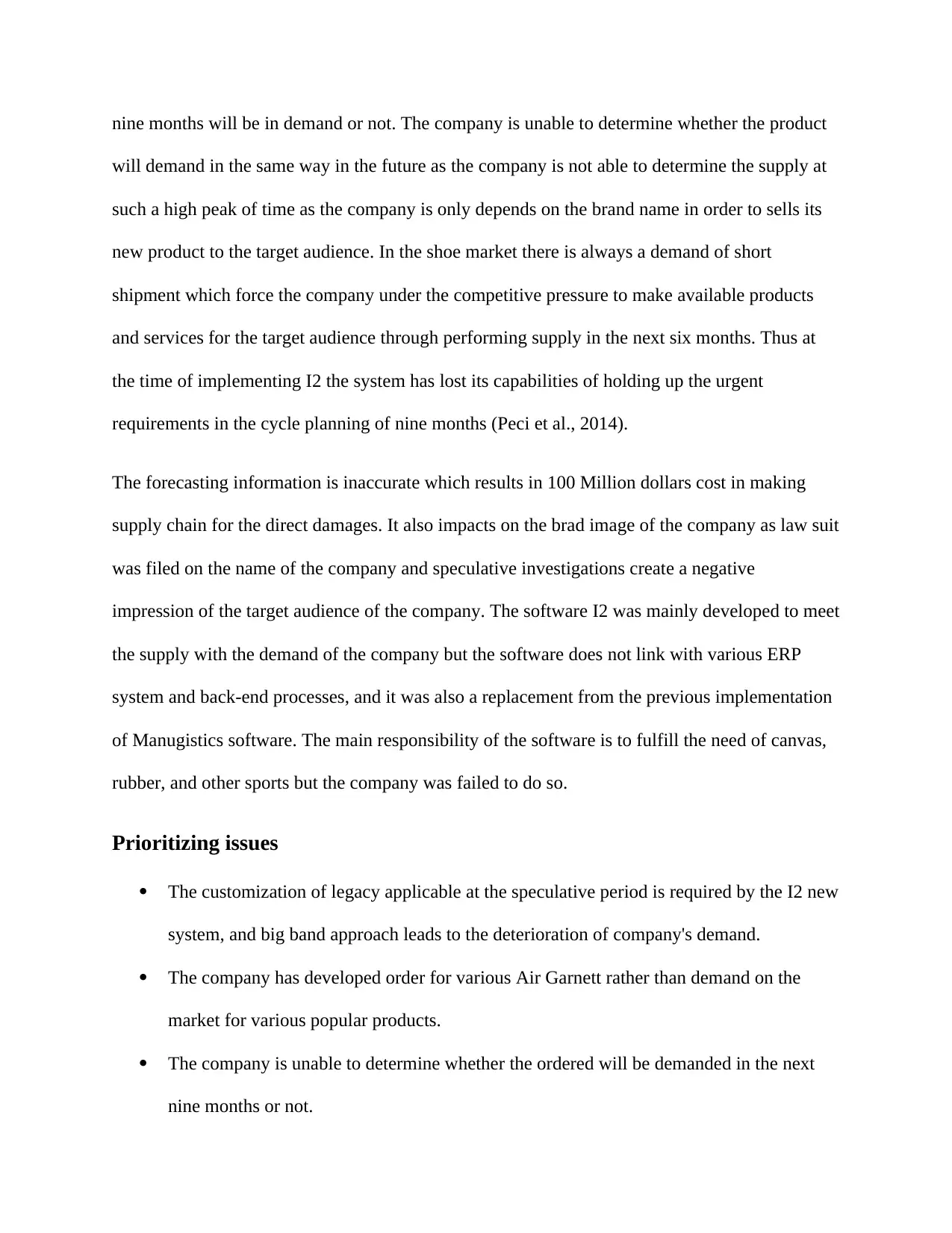
nine months will be in demand or not. The company is unable to determine whether the product
will demand in the same way in the future as the company is not able to determine the supply at
such a high peak of time as the company is only depends on the brand name in order to sells its
new product to the target audience. In the shoe market there is always a demand of short
shipment which force the company under the competitive pressure to make available products
and services for the target audience through performing supply in the next six months. Thus at
the time of implementing I2 the system has lost its capabilities of holding up the urgent
requirements in the cycle planning of nine months (Peci et al., 2014).
The forecasting information is inaccurate which results in 100 Million dollars cost in making
supply chain for the direct damages. It also impacts on the brad image of the company as law suit
was filed on the name of the company and speculative investigations create a negative
impression of the target audience of the company. The software I2 was mainly developed to meet
the supply with the demand of the company but the software does not link with various ERP
system and back-end processes, and it was also a replacement from the previous implementation
of Manugistics software. The main responsibility of the software is to fulfill the need of canvas,
rubber, and other sports but the company was failed to do so.
Prioritizing issues
The customization of legacy applicable at the speculative period is required by the I2 new
system, and big band approach leads to the deterioration of company's demand.
The company has developed order for various Air Garnett rather than demand on the
market for various popular products.
The company is unable to determine whether the ordered will be demanded in the next
nine months or not.
will demand in the same way in the future as the company is not able to determine the supply at
such a high peak of time as the company is only depends on the brand name in order to sells its
new product to the target audience. In the shoe market there is always a demand of short
shipment which force the company under the competitive pressure to make available products
and services for the target audience through performing supply in the next six months. Thus at
the time of implementing I2 the system has lost its capabilities of holding up the urgent
requirements in the cycle planning of nine months (Peci et al., 2014).
The forecasting information is inaccurate which results in 100 Million dollars cost in making
supply chain for the direct damages. It also impacts on the brad image of the company as law suit
was filed on the name of the company and speculative investigations create a negative
impression of the target audience of the company. The software I2 was mainly developed to meet
the supply with the demand of the company but the software does not link with various ERP
system and back-end processes, and it was also a replacement from the previous implementation
of Manugistics software. The main responsibility of the software is to fulfill the need of canvas,
rubber, and other sports but the company was failed to do so.
Prioritizing issues
The customization of legacy applicable at the speculative period is required by the I2 new
system, and big band approach leads to the deterioration of company's demand.
The company has developed order for various Air Garnett rather than demand on the
market for various popular products.
The company is unable to determine whether the ordered will be demanded in the next
nine months or not.
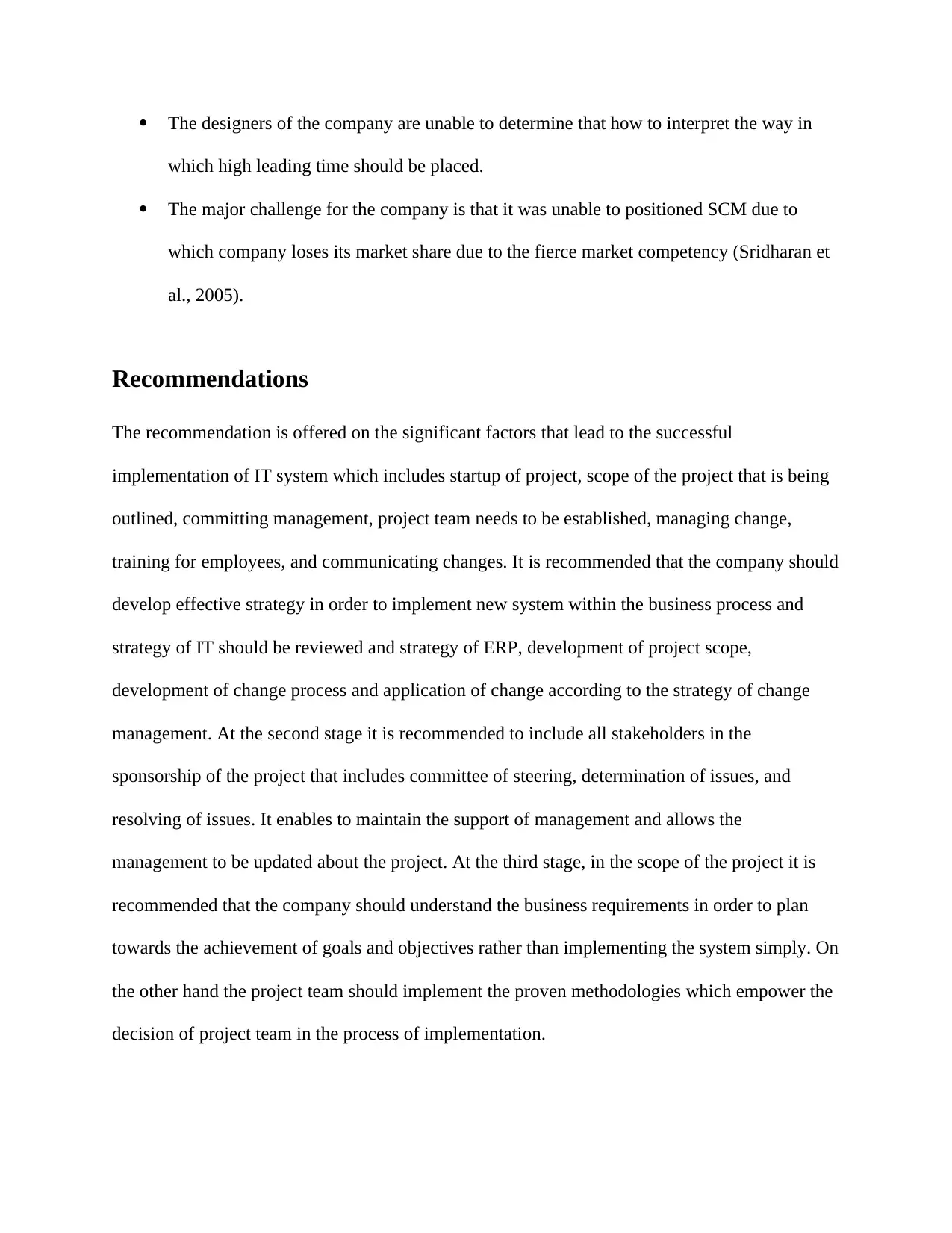
The designers of the company are unable to determine that how to interpret the way in
which high leading time should be placed.
The major challenge for the company is that it was unable to positioned SCM due to
which company loses its market share due to the fierce market competency (Sridharan et
al., 2005).
Recommendations
The recommendation is offered on the significant factors that lead to the successful
implementation of IT system which includes startup of project, scope of the project that is being
outlined, committing management, project team needs to be established, managing change,
training for employees, and communicating changes. It is recommended that the company should
develop effective strategy in order to implement new system within the business process and
strategy of IT should be reviewed and strategy of ERP, development of project scope,
development of change process and application of change according to the strategy of change
management. At the second stage it is recommended to include all stakeholders in the
sponsorship of the project that includes committee of steering, determination of issues, and
resolving of issues. It enables to maintain the support of management and allows the
management to be updated about the project. At the third stage, in the scope of the project it is
recommended that the company should understand the business requirements in order to plan
towards the achievement of goals and objectives rather than implementing the system simply. On
the other hand the project team should implement the proven methodologies which empower the
decision of project team in the process of implementation.
which high leading time should be placed.
The major challenge for the company is that it was unable to positioned SCM due to
which company loses its market share due to the fierce market competency (Sridharan et
al., 2005).
Recommendations
The recommendation is offered on the significant factors that lead to the successful
implementation of IT system which includes startup of project, scope of the project that is being
outlined, committing management, project team needs to be established, managing change,
training for employees, and communicating changes. It is recommended that the company should
develop effective strategy in order to implement new system within the business process and
strategy of IT should be reviewed and strategy of ERP, development of project scope,
development of change process and application of change according to the strategy of change
management. At the second stage it is recommended to include all stakeholders in the
sponsorship of the project that includes committee of steering, determination of issues, and
resolving of issues. It enables to maintain the support of management and allows the
management to be updated about the project. At the third stage, in the scope of the project it is
recommended that the company should understand the business requirements in order to plan
towards the achievement of goals and objectives rather than implementing the system simply. On
the other hand the project team should implement the proven methodologies which empower the
decision of project team in the process of implementation.
⊘ This is a preview!⊘
Do you want full access?
Subscribe today to unlock all pages.

Trusted by 1+ million students worldwide
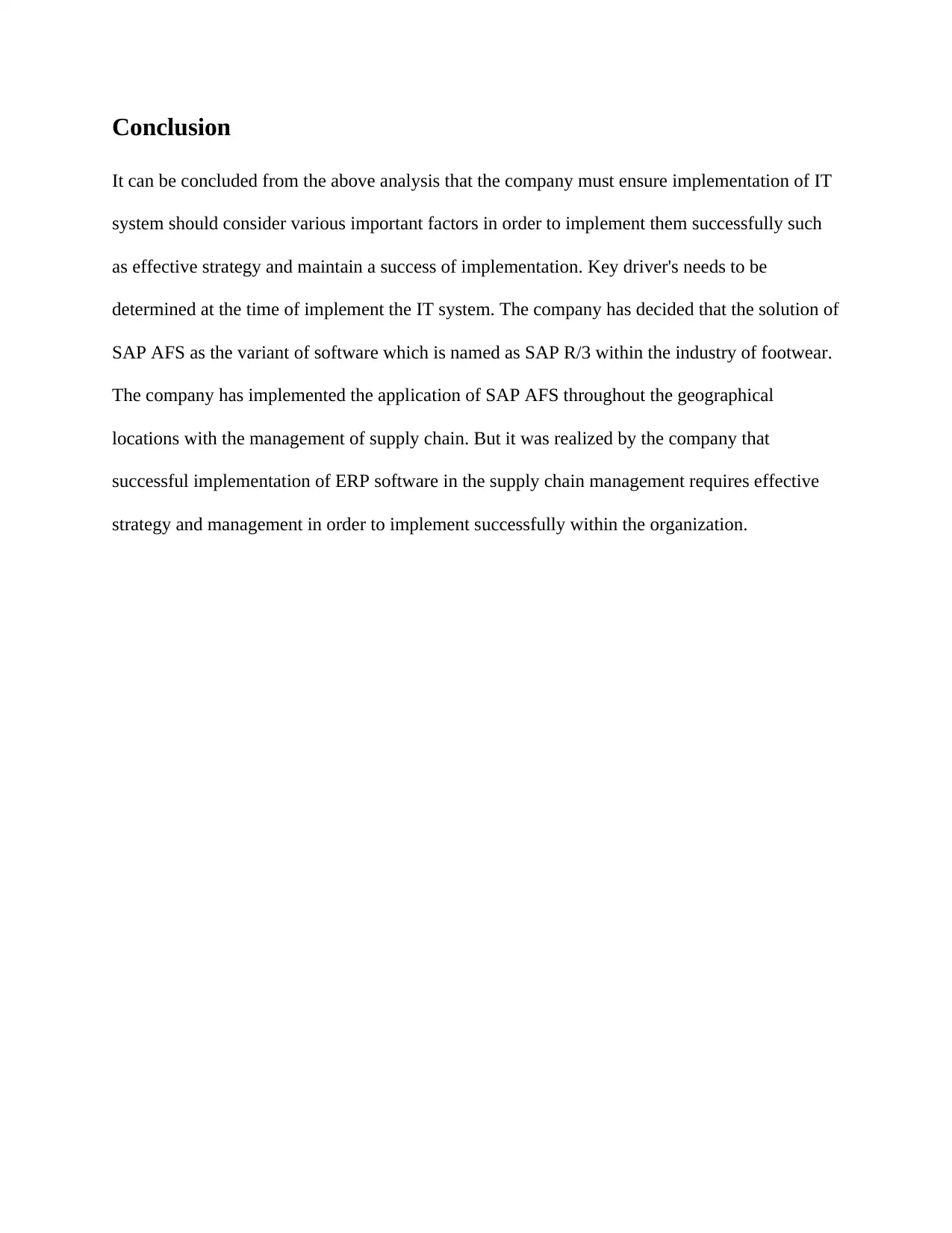
Conclusion
It can be concluded from the above analysis that the company must ensure implementation of IT
system should consider various important factors in order to implement them successfully such
as effective strategy and maintain a success of implementation. Key driver's needs to be
determined at the time of implement the IT system. The company has decided that the solution of
SAP AFS as the variant of software which is named as SAP R/3 within the industry of footwear.
The company has implemented the application of SAP AFS throughout the geographical
locations with the management of supply chain. But it was realized by the company that
successful implementation of ERP software in the supply chain management requires effective
strategy and management in order to implement successfully within the organization.
It can be concluded from the above analysis that the company must ensure implementation of IT
system should consider various important factors in order to implement them successfully such
as effective strategy and maintain a success of implementation. Key driver's needs to be
determined at the time of implement the IT system. The company has decided that the solution of
SAP AFS as the variant of software which is named as SAP R/3 within the industry of footwear.
The company has implemented the application of SAP AFS throughout the geographical
locations with the management of supply chain. But it was realized by the company that
successful implementation of ERP software in the supply chain management requires effective
strategy and management in order to implement successfully within the organization.
Paraphrase This Document
Need a fresh take? Get an instant paraphrase of this document with our AI Paraphraser
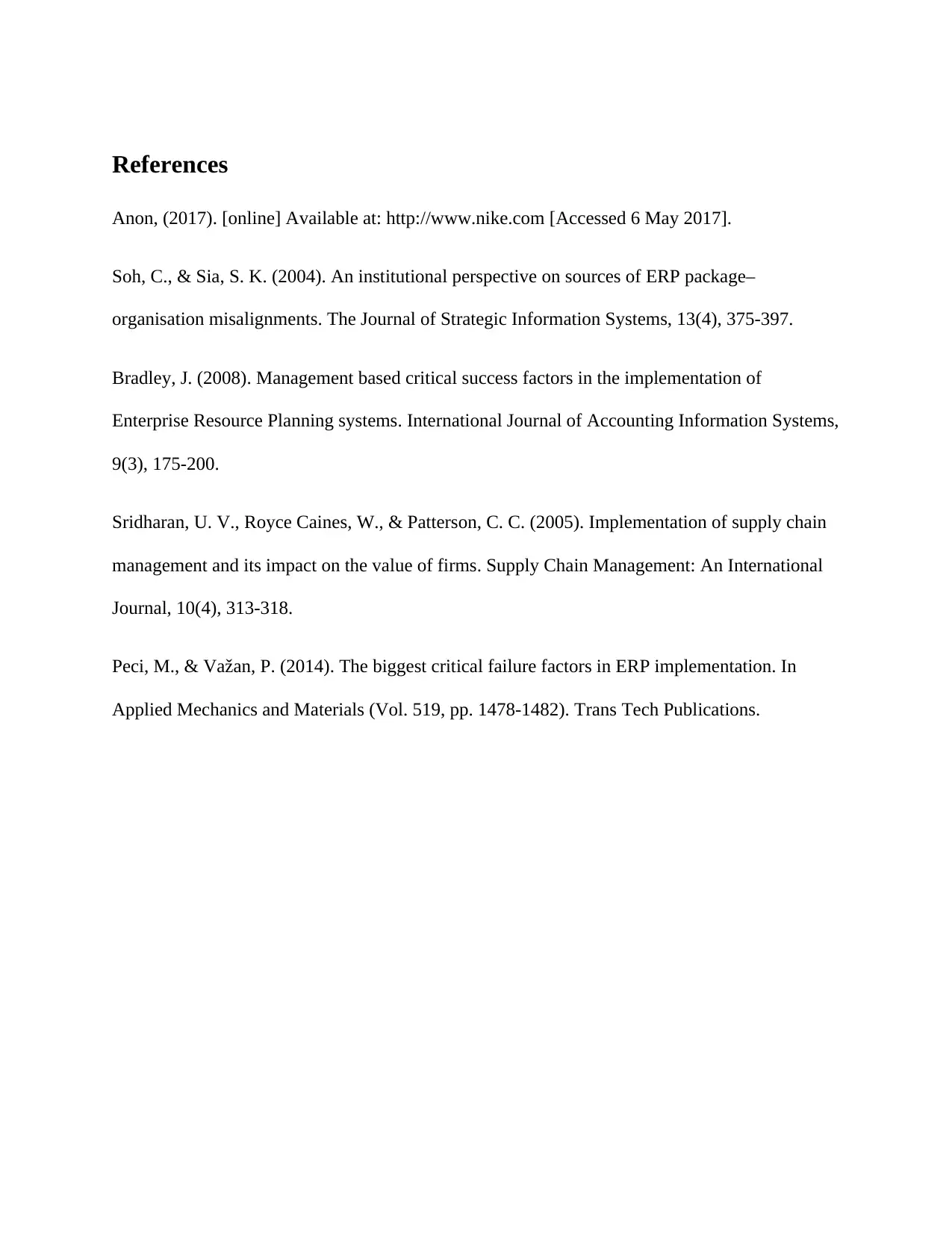
References
Anon, (2017). [online] Available at: http://www.nike.com [Accessed 6 May 2017].
Soh, C., & Sia, S. K. (2004). An institutional perspective on sources of ERP package–
organisation misalignments. The Journal of Strategic Information Systems, 13(4), 375-397.
Bradley, J. (2008). Management based critical success factors in the implementation of
Enterprise Resource Planning systems. International Journal of Accounting Information Systems,
9(3), 175-200.
Sridharan, U. V., Royce Caines, W., & Patterson, C. C. (2005). Implementation of supply chain
management and its impact on the value of firms. Supply Chain Management: An International
Journal, 10(4), 313-318.
Peci, M., & Važan, P. (2014). The biggest critical failure factors in ERP implementation. In
Applied Mechanics and Materials (Vol. 519, pp. 1478-1482). Trans Tech Publications.
Anon, (2017). [online] Available at: http://www.nike.com [Accessed 6 May 2017].
Soh, C., & Sia, S. K. (2004). An institutional perspective on sources of ERP package–
organisation misalignments. The Journal of Strategic Information Systems, 13(4), 375-397.
Bradley, J. (2008). Management based critical success factors in the implementation of
Enterprise Resource Planning systems. International Journal of Accounting Information Systems,
9(3), 175-200.
Sridharan, U. V., Royce Caines, W., & Patterson, C. C. (2005). Implementation of supply chain
management and its impact on the value of firms. Supply Chain Management: An International
Journal, 10(4), 313-318.
Peci, M., & Važan, P. (2014). The biggest critical failure factors in ERP implementation. In
Applied Mechanics and Materials (Vol. 519, pp. 1478-1482). Trans Tech Publications.
1 out of 8
Related Documents
Your All-in-One AI-Powered Toolkit for Academic Success.
+13062052269
info@desklib.com
Available 24*7 on WhatsApp / Email
![[object Object]](/_next/static/media/star-bottom.7253800d.svg)
Unlock your academic potential
Copyright © 2020–2025 A2Z Services. All Rights Reserved. Developed and managed by ZUCOL.





